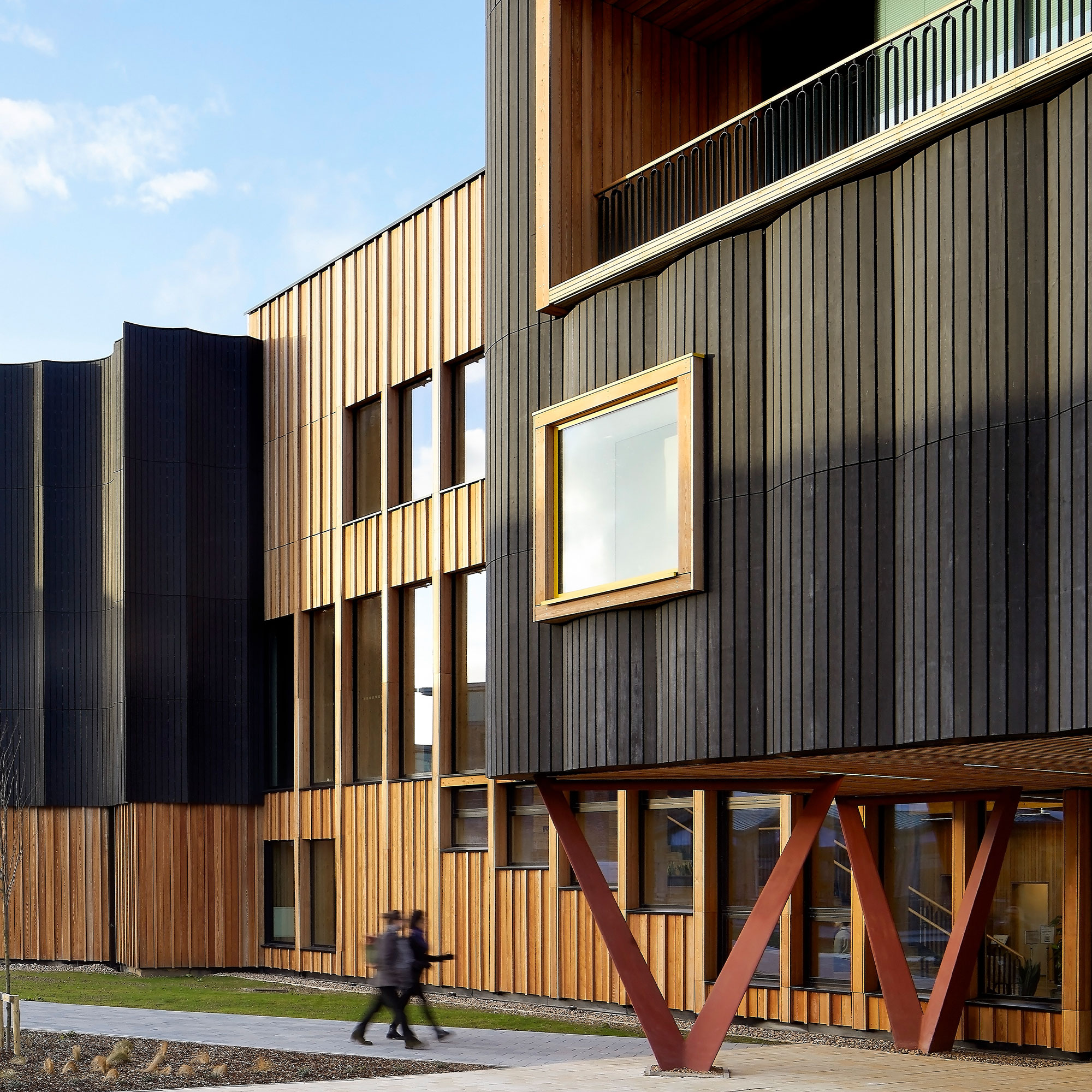Tate + Co’s new Creative Centre for the York St John University is designed to be loose fit and accessible to all, suiting the needs of a growing university.
Words
Jason Sayer
Photos
Hufton+Crow
York is one of England’s most historic and treasured cities. Notably for its built environment, this means a great majority of its architecture was not built this century, nor the century before that either. Yet many of its buildings have emphatically stood the test of time, able to be repurposed and adapted for use in today’s ever-changing world. HVAC didn’t exist in the 11th Century when the first stones were being laid for what would become York Minster cathedral, but this is evidence of what good building fabric can really achieve. The Romans knew this, as did the Normans that came after them.
Jerry Tate of Tate + Co, the London-based practice behind the new Creative Centre at York St John University (YSJ), knows it too. “This building could become anything in the future,” he said during press tour of the building. “It’s an incredibly loose-fit building.”
Acoustic a theatre consultants Sound Space Vision worked on the Creative Centre’s auditorium to ensure optimum acoustic performance.
The Creative Centre sits adjacent to YSJ’s student union, among a coterie of other university buildings to the north of the former English capital. York is a walkable city, so a stroll along Dame Judi Dench Walk to get to the building is fitting for those who will use the Creative Centre to perform or rehearse.
Inside the centre, a 200-seater auditorium boasts a fully accessible rigging system. The auditorium is the building’s most defined space in terms of programme and the university is keen for it to be used by more than just theatre students. “We only teach for 30 weeks a year. When it’s not being used, we want to use it for community activities, school places, academic conferences, comedy venue, live music and whatever else it can be used for,” explains YSJ’s Chief Operating Officer Rob Hickey.
For this to happen, services have been made easy to change and adapt when necessary by environmental consultant Atelier Ten, allowing the auditorium – and indeed other spaces – to be as malleable as possible. “It’s a very simply serviced space; the same for the whole building,” David McAllister, associate director at Atelier Ten told Architecture Today. “This building will change. We didn’t want to look hide services away for when that moment happens. The aim is to minimise the constraints we put on people in the future.”
The long-life, loose fit approach is part of a sustainable strategy that dovetails at a material level too. The building is wrapped in prefabricated chestnut timber cladding and inside convex, scalloped timber battens have been arranged in an undulating and staggered pattern to disperse and diffuse multiple sound frequencies within the auditorium.
In dramatic fashion, 14-metre-high glulam timber columns span a triple-height atrium, a space that is the Creative Centre’s nexus. Facing southward, light fills the atrium through a triple-glazed curtain wall and roof in which square apertures have been punched through timber soffits.
Stairs double up as seating, hugging the glazed façade which frames views of York Minster and a stubby bit of centuries-old Gothic architecture pokes out above a more immediate roofline. The aim is for the atrium to be used as a “living room” by the students — a place to relax and congregate beyond the student union and dining halls; already, it’s being well used. It’s not all timber: red oxide-coloured steel punctuates sections of cross-laminated timber (CLT) and glulam, serving as a structural component in conjunction with the timber.
The atrium will be the circulatory point of orientation for those on music and computer science courses where rooms have been provided for — such as space for more private music rehearsal and computer labs and lecture theatres. The idea is for these disciplines to collide, or at least be able to work together in some capacity, with students following in the footsteps of those that have gone on to produce video game music and digitally-enabled theatrical productions.
Left: on the top floor are a series of music rooms. High ceilings minimise acoustic exposure to those, such as teachers, who could occupy the room for long periods of time.
Despite this, Tate and the university were keen to stress that this was not a building attached to a department — a position in line with YSJ’s plans for expansion. At the time of writing, the university, which started life as a teaching training college and only becoming an independent university in 2005, has around 8,500 students in York, but has ambitions to grow that number significantly in the coming years.
Cores, which double-up as risers for heat recovery, exist at either end of the Creative Centre, meaning the building can be easily extended. A masterplan has also been outlined: planned by Tate + Co and prescribing new, extensive landscaping to enrich the surrounding area over the next three years. By then, the university hopes to have more than 10,000 students in the city.
After sunset, the activity in the atrium is illuminated, advertising the space and its alternative functions to others.
Additional Images
Download Drawings
Project team
Client
York St John University
Architect
Tate+Co
QS & Project Managers
Robinson Low Francis
M&E engineer
Atelier Ten
BREEAM
Atelier Ten
Lighting Designer
Atelier Ten
Structural engineer
Atelier One
Acoustic & Theatre consultant
Sound Space Vision
Access consultant
Sensory Trust
Landscape architect
Colour
Planning consultant
McKenzie Town Planning
Source: Architecture Today






